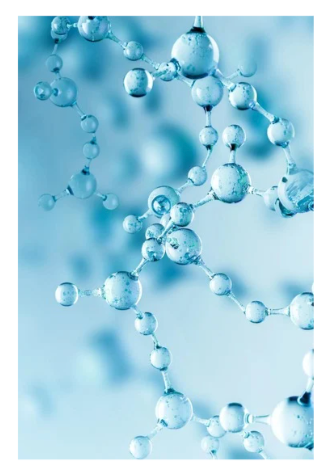Redefine Natural Skincare
Hailed for their remarkable hydration properties, key ingredients from both land and sea are redefining how we approach skin health and beauty.


Marine Based Molecular Skincare
What even IS hyaluronic acid?
Hyaluronic acid (HA) is a naturally occurring glycosaminoglycan, which is a type of molecule composed of sugars that is present in connective tissue throughout the body, with high concentrations in the skin, eyes, and joints. It plays a critical role in retaining moisture, as it can hold up to 1,000 times its weight in water, making it essential for maintaining hydration in tissues.
To qualify as hyaluronic acid, a substance must meet the following criteria:
-
Chemical Structure: It should have the chemical composition of (C₁₄H₂₁NO₁₁)n, where 'n' represents the number of repeating disaccharide units of glucuronic acid and N-acetylglucosamine.
-
Biological Source: Hyaluronic acid can be derived from animal sources (such as rooster combs), bacterial fermentation, or plant-based alternatives that mimic its properties.
-
Functionality: It must exhibit the ability to bind and retain water, providing hydration, lubrication, and structural support to tissues. This property is pivotal in skincare for maintaining skin moisture and plumpness.
-
Molecular Weight: Hyaluronic acid can come in various molecular weights, affecting its application and function. High molecular weight HA primarily works on the surface of the skin to provide a barrier, while low molecular weight HA can penetrate deeper into the skin layers for more intense hydration and repair.
In the context of Nama Fiji's products, the sea grapes (nama) are referred to as a vegan hyaluronic acid, as they provide similar hydrating and moisture-retaining benefits as traditional hyaluronic acid, but aren't derived from bacteria or synthesized in a lab like many hyaluronics used in skincare.
Nama are sea grapes that grow wild in the blue lagoon waters of the Yasawa Islands. Caulerpa racemosa, its scientific name, is a species of green algae found in marine environments, particularly in tropical and subtropical regions. The sea grapes are small, round, and grow on branching stems, giving them a grape-like look, and have been a traditional delicacy used in various culinary dishes for their unique texture and briny flavor.
Nama sea grapes are packed with many vitamins and minerals, most of which support a healthy immune system, however it also contains notable levels of antioxidants like chlorophyll and betacarotene, amino acids for protein, even Omega-3s and dietary fiber:
Vitamins found in Nama:
- Vitamin A: Essential for vision, immune function, and skin health
- Vitamin C: An antioxidant that supports the immune system, collagen production, and cell protection
- Vitamin E: Protects cells from oxidative stress and supports skin health
- Vitamin K: Important for blood clotting and bone health
- B Vitamins: Including B1 (thiamine), B2 (riboflavin), B3 (niacin), and B9 (folate), vital for energy production, brain function, and red blood cell formation
Minerals found in Nama:
- Calcium: Supports bone and teeth health, muscle function, and nerve signaling
- Magnesium: Important for muscle and nerve function, blood sugar control, and bone health
- Iron: Necessary for hemoglobin production and oxygen transport in the blood
- Potassium: Regulates fluid balance, muscle contractions, and nerve signals
- Sodium: Maintains fluid balance and proper nerve and muscle function
- Iodine: Essential for thyroid function and hormone production
- Zinc: Supports immune function, wound healing, DNA synthesis, and cell division
In conjunction with James Cook University in Australia, Caulerpa Racemosa was tested against other seaweeds in the family to determine its nutritional and mineral content, where it was found to have twice the antioxidants (100 mg g ‐1 FW) of its competitors. It was also discovered that nama has very high trace elements of selenium (124.0 vs. 3.9 ppm) versus Caulerpa Lentillifera, the more common, commercialized sea grape found throughout Asia and the Pacific Islands. Selenium is commonly known for its health benefits, used frequently in agriculture and food fortification or in antifungal applications, but selenium also impacts thyroid function, protects cells from free radical damage, and can reduce inflammation.
This study also found Caulerpa Racemosa is not responsive to large-scale aquaculture due to its inability to grow well in a lab setting; nama has to grow wild in order to develop properly and be as effective as it can. Aquaculture ranching using wild harvests could be a viable option, and will be tested in choice locations in Fiji to see if the environmental conditions effect vitamin and mineral development.




Leave a comment